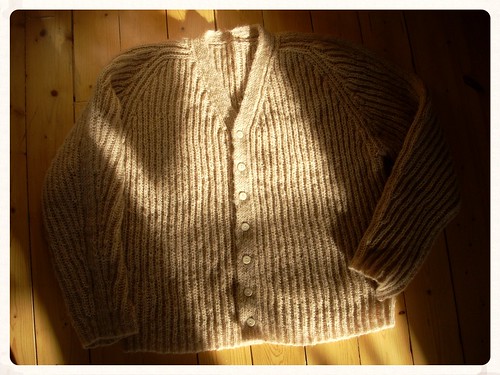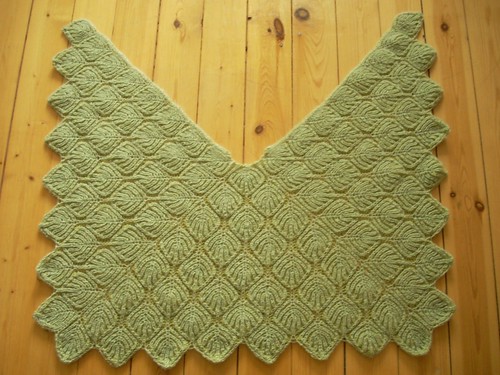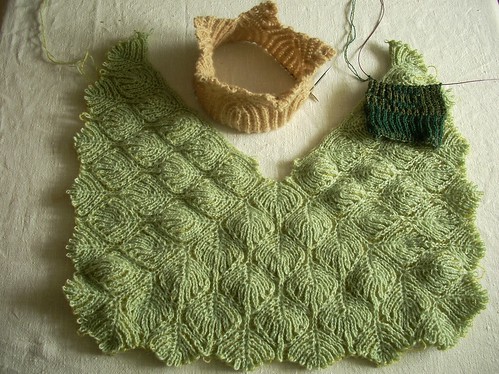I'm in a finishing mood, to the extent that I've even sewn seven buttons. (I appreciate Gwen Raverat's words "sewing was downright wicked slavery" in her adorable book Period Piece. A Cambridge Childhood.) The brioche cardigan had actually been finished for more than a week before I got around to it, even though I'd already found the perfect buttons... They're made of marble and I think they look fabulous with the wool. Their size was exactly right for the buttonholes too!
Some time ago I wrote a post about the shoulder straps: here's how they turned out:
I've finished the Monk no 2 sweater as well. Not that Marianne Isager's
name "Monk" is very suitable anymore as I didn't keep the hood.
Also, I've made up my mind about the collar for my double-knitted jacket/cardigan. I've tried various ideas: I wanted something different from the main pattern and tried both triangles and stripes but wasn't satisfied. Then I suddenly thought I'd keep the small squares but use them into lego-like brick shapes. Of all the things I love about knitting, I think I like solving difficulties best.
Showing posts with label Nancy Marchant. Show all posts
Showing posts with label Nancy Marchant. Show all posts
Thursday, 6 March 2014
Wednesday, 29 January 2014
Brioche and double knitting
Unexpectedly, I haven't bought any yarn so far this year - nothing related to knitting, actually. Instead, I'm making - enjoyable - efforts to decide how to make use of what I've already got.
2013 was a brioche and double knitting year for me. I learnt the basics of brioche knitting as a child and always liked how it feels, but it was only after seeing Nancy Marchant's projects and reading her book Knitting Brioche that I began to understand its enormous potential. Last year I also decided to learn double knitting at long last, which took my knitting mind in new directions.
What I'm making now (among many other things) is a cardigan combining the two techniques: a brioche cardigan with double-knitted edges for buttons and buttonholes. Nancy Marchant's "The Book Exchange Cardigan" (Ravelry link) is my inspiration, but with some modifications.
This wool is 90% camel: wonderfully soft and incredibly warm. I live in an old building, which is incredibly charming but cooold. I love the colour, but I will probably look like my dear old teddy bear Åsanalle.
Last, some great advice which I forgot to bring up when I wrote about finishing my "Alba" cardigan recently.
Right before I started cutting the steeks I mercifully remembered the scissors needed to be cleaned carefully as I had been cutting fins off herrings earlier in the evening! So, don't forget to clean your herring-and-steeks scissors - unless you want your fishermen's sweaters as authentic as possible, of course.
2013 was a brioche and double knitting year for me. I learnt the basics of brioche knitting as a child and always liked how it feels, but it was only after seeing Nancy Marchant's projects and reading her book Knitting Brioche that I began to understand its enormous potential. Last year I also decided to learn double knitting at long last, which took my knitting mind in new directions.
What I'm making now (among many other things) is a cardigan combining the two techniques: a brioche cardigan with double-knitted edges for buttons and buttonholes. Nancy Marchant's "The Book Exchange Cardigan" (Ravelry link) is my inspiration, but with some modifications.
This wool is 90% camel: wonderfully soft and incredibly warm. I live in an old building, which is incredibly charming but cooold. I love the colour, but I will probably look like my dear old teddy bear Åsanalle.
Last, some great advice which I forgot to bring up when I wrote about finishing my "Alba" cardigan recently.
Right before I started cutting the steeks I mercifully remembered the scissors needed to be cleaned carefully as I had been cutting fins off herrings earlier in the evening! So, don't forget to clean your herring-and-steeks scissors - unless you want your fishermen's sweaters as authentic as possible, of course.
Thursday, 3 October 2013
Brioche shawl finished
Here's the brioche shawl I made based on Nancy Marchant's "Alex" scarf (Ravelry link here). I decreased and cast off each leaf separately, so there were quite a few loose ends to take care of. However, I made it easy for myself by using a crochet hook and simply pulling them through a number of brioche yarnovers.
A Starmore addict I've cast on to make yet another of her designs, namely "Inishmore" from Fishermen's Sweaters. The yarn is Cascade 220, and I think this light colour works well with this kind of cable pattern.
 |
| Inishmore in progress |
A Starmore addict I've cast on to make yet another of her designs, namely "Inishmore" from Fishermen's Sweaters. The yarn is Cascade 220, and I think this light colour works well with this kind of cable pattern.
Friday, 23 August 2013
Barking and burping
Those are Nancy Marchant's words based on the abbreviations brk (brioche knit) and brp (brioche purl). A voracious knitter I'm especially fond of burping.
I had no idea the technique had so many possibilities. In the photo there are three examples:
1. A two-colour shawl where the pattern is created using increases and decreases. (I discovered a mistake a few rows back, which is why I pulled out the needle. Irritating, but it gave me an opportunity to see how it is turning out.)
2. A single-colour cowl knitted in the round with increases and decreases to make a nice edge.
3. A two-colour swatch where the knit and purl columns change places; this affects which colour is brought forward.
I can't remember when I last learnt so many things in such short time - and I haven't even tried brioche cables or diagonal lines or...
Patentstickning är något jag har gillat sedan farmor lärde mig grunderna, men det är först nu jag har förstått vilka möjligheter som finns med tekniken. Eftersom jag egentligen bara kunde sticka fram och tillbaka med en färg (ett rätt misslyckat försök att sticka runt för några år sedan räknas knappast) tyckte jag att det blev för enformigt för att göra hela plagg, men nu har jag drabbats av patentfrossa.
Fotot visar tre varianter: en sjal med två färger där mönstret skapas med ökningar och minskningar; en fuskpolo som stickas runt och kanten formas med ökningar och minskningar; en provlapp med två färger där de räta och aviga kolumnerna byter plats, vilket innebär att det växlar mellan vilken av färgerna som blir dominant. Och det finns mängder kvar att testa!
I had no idea the technique had so many possibilities. In the photo there are three examples:
1. A two-colour shawl where the pattern is created using increases and decreases. (I discovered a mistake a few rows back, which is why I pulled out the needle. Irritating, but it gave me an opportunity to see how it is turning out.)
2. A single-colour cowl knitted in the round with increases and decreases to make a nice edge.
3. A two-colour swatch where the knit and purl columns change places; this affects which colour is brought forward.
I can't remember when I last learnt so many things in such short time - and I haven't even tried brioche cables or diagonal lines or...
Patentstickning är något jag har gillat sedan farmor lärde mig grunderna, men det är först nu jag har förstått vilka möjligheter som finns med tekniken. Eftersom jag egentligen bara kunde sticka fram och tillbaka med en färg (ett rätt misslyckat försök att sticka runt för några år sedan räknas knappast) tyckte jag att det blev för enformigt för att göra hela plagg, men nu har jag drabbats av patentfrossa.
Fotot visar tre varianter: en sjal med två färger där mönstret skapas med ökningar och minskningar; en fuskpolo som stickas runt och kanten formas med ökningar och minskningar; en provlapp med två färger där de räta och aviga kolumnerna byter plats, vilket innebär att det växlar mellan vilken av färgerna som blir dominant. Och det finns mängder kvar att testa!
Friday, 16 August 2013
Learning new tricks
At a knitting event a couple of weeks ago I was inspired to develop my brioche knitting skills. As I only knew the very basics of the technique, there was (and still is) a lot of room for improvement - and I had no idea what possibilities there are!
A workshop leader myself I couldn't participate in any classes, but when Nancy Marchant talked about brioche knitting and showed examples of what you can make with the technique I knew I had to try it. I’ve ordered her book Knitting Brioche, and while waiting for it to arrive I have taken her class at Craftsy. Highly recommended!
The shawl I’m making with two colours is based on a rectangular scarf pattern that is included in the Craftsy class. (Ravelry link here.) It is a fascinating technique in many ways, like the way you create patterns using increases and decreases.
When I knit lace shawls I like thinking of bricks of various shapes that build a shawl, and realized I could think in a similar way with these ”leaf bricks” constructing the shawl shape by adding leaves.
När jag var kursledare på Stickstämma 2013 i Jämtland för ett par veckor sedan kunde jag ju inte gå några kurser själv, men i programmet fanns fyra föredrag som alla kunde lyssna på. Bland annat pratade Nancy Marchant om patentstickning, och det var mycket inspirerande att se vad det går att göra med den tekniken! Jag lärde mig grunderna av farmor, men nu fick jag se många exempel på hur man kan arbeta med färger och skapa mönster med hjälp av ökningar och minskningar.
I väntan på hennes bok Knitting Brioche har jag lärt mig massor av Nancys nätbaserade kurs på Craftsy och börjat leka med en sjal. Bladet är från ett mönster som ingår i kursen, men jag ville se om jag kunde använda formen på ett annat sätt än i en halsduk. Det är roligt att passa ihop mönsterform och sjalform!
A workshop leader myself I couldn't participate in any classes, but when Nancy Marchant talked about brioche knitting and showed examples of what you can make with the technique I knew I had to try it. I’ve ordered her book Knitting Brioche, and while waiting for it to arrive I have taken her class at Craftsy. Highly recommended!
The shawl I’m making with two colours is based on a rectangular scarf pattern that is included in the Craftsy class. (Ravelry link here.) It is a fascinating technique in many ways, like the way you create patterns using increases and decreases.
When I knit lace shawls I like thinking of bricks of various shapes that build a shawl, and realized I could think in a similar way with these ”leaf bricks” constructing the shawl shape by adding leaves.
 |
| brioche shawl: wrong side |
I väntan på hennes bok Knitting Brioche har jag lärt mig massor av Nancys nätbaserade kurs på Craftsy och börjat leka med en sjal. Bladet är från ett mönster som ingår i kursen, men jag ville se om jag kunde använda formen på ett annat sätt än i en halsduk. Det är roligt att passa ihop mönsterform och sjalform!
Subscribe to:
Posts (Atom)








